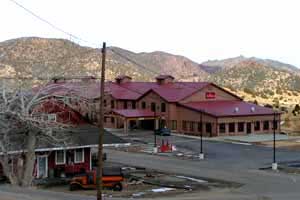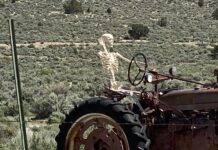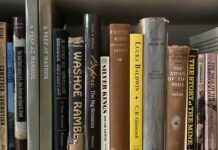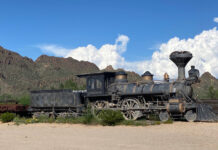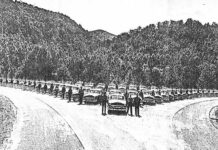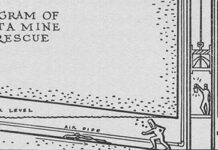Is it a mistake for me to be your guide to Virginia City?
I know too much.
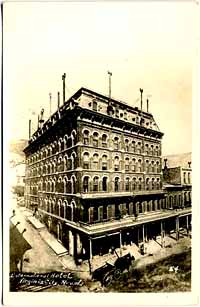 It’s helpful to be able to point out that B Street was once Virginia City’s Champs-Elysees. It’s just a parking lot now, but the main entrance to the International Hotel was on B Street, across from Piper’s Opera House. The Miner’s Union Hall was there, the Storey County Court House still dominates the next block south, and B Street is still lined with mansions on the west side beyond that. Jim Fair lived on B Street, to give you an idea.
It’s helpful to be able to point out that B Street was once Virginia City’s Champs-Elysees. It’s just a parking lot now, but the main entrance to the International Hotel was on B Street, across from Piper’s Opera House. The Miner’s Union Hall was there, the Storey County Court House still dominates the next block south, and B Street is still lined with mansions on the west side beyond that. Jim Fair lived on B Street, to give you an idea.
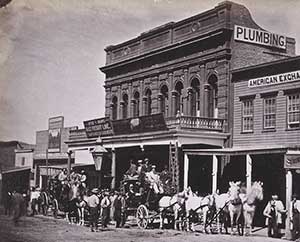 And C Street was the mercantile boulevard, the shopping street, busy with pedestrians dodging the horse-drawn traffic of all kinds. Wells Fargo’s office was on C Street along with stock brokers, banks and attorneys-at-law among the Dry Goods stores, groceries and haberdashers.
And C Street was the mercantile boulevard, the shopping street, busy with pedestrians dodging the horse-drawn traffic of all kinds. Wells Fargo’s office was on C Street along with stock brokers, banks and attorneys-at-law among the Dry Goods stores, groceries and haberdashers.
And over there, just outside that shop on the board sidewalk Bob McKinney was shot and killed by a Storey County deputy sheriff for brandishing a pen-knife. Bob’s mom had moved to Virginia City when he was in the Army but had died before he came ‘home’ . Over the years after he became a strange and forlorn figure who lived out in the sagebrush and annoyed some people by fishing through the trash barrels on C Street for food. The solution was to shoot him down in the street.
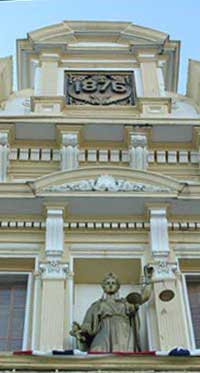 And that unblindfolded justice over the entrance to the Court House, how quaint that must appear to a visitor. I thought it was quaint once myself, before I saw the antics of our governing bodies as they struggled with the open pit mining threat to Gold Hill. I have been told to sit down and shut up by a County Commissioner in a public meeting and I have watched others being hustled out of Commission meetings for speaking out.
And that unblindfolded justice over the entrance to the Court House, how quaint that must appear to a visitor. I thought it was quaint once myself, before I saw the antics of our governing bodies as they struggled with the open pit mining threat to Gold Hill. I have been told to sit down and shut up by a County Commissioner in a public meeting and I have watched others being hustled out of Commission meetings for speaking out.
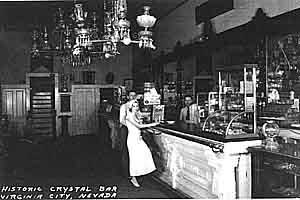
And I sat through the selling out of Gold Hill and giving up the Virginia City National Historic Landmark to pit mining without a qualm, for the benefit of the mining company.
How quaint is that?
I mention those things as a reminder that Virginia City is not a theme park or a movie set, and that the history we goggle over has never ended. This is a living community with real people living in it, some of them exhibiting the same unfortunate character flaws as the worst of the pioneers.

It’s hard to set all that aside and present Virginia City as simply a fascinating place, both for its astonishing history and for the unequalled collection of Victorian architecture and infrastructure left over for us to feast our eyes on. But I’ll try. The Court House itself is open during business hours for your inspection, with an elevator to bypass the steep stairs. It’s a beautiful building with high ceilings, affable employees and a peace officer museum toward the back.
In an effort to re-acquaint myself with the Virginia City awaiting visitors and block out the rest, Robin and Shorty and I made the drive there (one mile) early one morning in May and we discovered right away that people sleep late up there. The two coffee houses don’t open until 7 am and The Roasting House didn’t have enough customers to support a conversation until after 8.
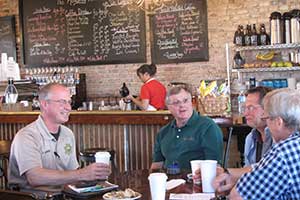
And when the conversation did erupt, it was all about politics — not about the issues, but who was going to win the upcoming primary election. As two of the five people around the table were candidates facing elimination, this was not abstract speculation. A nice taste of drama to start the day . . . we don’t get that in Gold Hill.
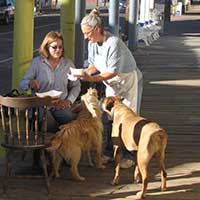
While at The Roasting House I bought a copy of a booklet published by the Comstock Cemetery Foundation containing the selected obituaries of some of those buried in the Silver City, Gold Hill and Virginia City cemeteries. It is a curiously affecting souvenir from the past and provides a strong taste of the 19th century, before the AP Stylebook was drafted, when everything was personal. You’ll find two of the obituaries in a box further down the page.
 It’s sunny and quiet on a late spring morning, and Virginia City is no longer the busy, dirty, noisy industrial city it was in its earliest incarnation.
It’s sunny and quiet on a late spring morning, and Virginia City is no longer the busy, dirty, noisy industrial city it was in its earliest incarnation.
What’s left of those glory years, apart from the structures that line the streets, has been put in museums, of which there are 16 in Virginia City. There were 17 until the Radio Museum closed recently, but 16 still seems like a lot, even when you’re welcoming a million visitors a year or more.
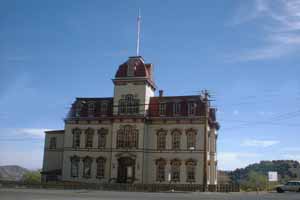
There is an aura of sadness about historical museums, it seems to me, with their emphasis on the vanished past, with everyday tools displayed behind glass, and pictures of the dead — whole families sometimes! — on the walls. There is no doubt that those people accomplished miracles, and a well-curated museum can be a big education in small things.
I am planning a museum crawl on Friday because on the First Friday of each month all 16 Museums in Virginia City waive their entrance fees, and I am going to give some of them a try.
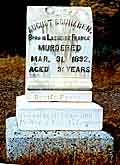 One of these ‘museums’ is the collection of cemeteries called The Silver Terraces on Virginia City’s north side, and reading the obituaries had stirred our interest in it. It is being slowly restored to its former elegance, a process that began 40 years ago as a volunteer effort by Father Paul Meinecke of St. Mary’s in the Mountains.
One of these ‘museums’ is the collection of cemeteries called The Silver Terraces on Virginia City’s north side, and reading the obituaries had stirred our interest in it. It is being slowly restored to its former elegance, a process that began 40 years ago as a volunteer effort by Father Paul Meinecke of St. Mary’s in the Mountains.
|
In the Prime of Life and Usefulness Dec 1 1869 Mrs. Bridget Curran, Aged about 45 years old got her hoops caught on the end of a shaft in the Sunderland mill lower Gold Hill about 10 1/2 o’clock today and wound round so tight that she was carried around 20 or 30 times, her head beating the floor every time. They had to stop the mill so as to get her loose, had to chop off the hoops with a hatchet. She was insensible and remained so till she died about 2 hours afterward. No bones were broken, died of concussion of the brain. Leaves a husband and 2 or 3 sons in Gold Hill. She went into the mill to get some condensed water from a barrel, where all the neighbors had the same privilege, good to wash or cook with, soft water. January 4, 1877 Twice Buried. Frankie Dall, who before her death was a woman of the town, died a natural death last Monday night in the house just north of the Imperial hoisting works. She was taken from that place by Wilson & Brown undertakers, and buried in a rough redwood box at the expense of the county. On Tuesday some of her old associates clubbed together and resolved to give the woman a decent burial. They took an express wagon and going to the graveyard dug up the unfortunate. The body was returned to the undertaking rooms of Wilson & Brown, where it was today laying in state. An elegant and expensive coffin has been purchased and the trappings of woe are as fine as can be procured. The outfit will cost $15. Tomorrow the second funeral will take place and it will no doubt be well attended. George Prior has taken a kindly interest in the matter, and has aided greatly in raising money to pay the necessary expenses. — Alexis Dillon, editor |
Father Meinecke rests here now himself, and the work he began continues under the auspices of the Comstock Cemetery Foundation.
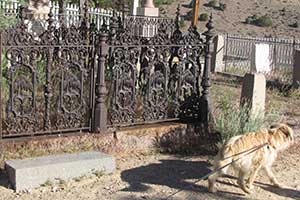 There are 11 separate cemetery properties here, and 150 years ago, when the tracts were being developed — the Exempt Firemen were the first to stake their claim, in 1860 — the rugged hillside was transformed into a green and graceful park with picket fences between the tracts, and graveled tree-shaded boulevards between the fences.
There are 11 separate cemetery properties here, and 150 years ago, when the tracts were being developed — the Exempt Firemen were the first to stake their claim, in 1860 — the rugged hillside was transformed into a green and graceful park with picket fences between the tracts, and graveled tree-shaded boulevards between the fences. 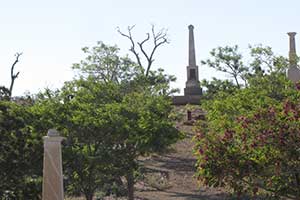 A ‘Sunday Drive’ in a rented buggy would include a visit to the Silver Terraces whether there was family interred here or not. This was Virginia City’s first park, and its first museum too.
A ‘Sunday Drive’ in a rented buggy would include a visit to the Silver Terraces whether there was family interred here or not. This was Virginia City’s first park, and its first museum too.
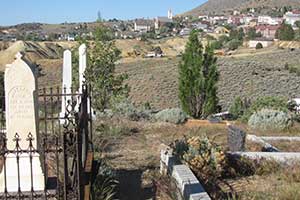 Spring mornings are glorious on the Comstock (when there’s no blizzard), and much to Shorty’s satisfaction the cemeteries welcome properly picked-up-after dogs. Robin and Shorty and I strolled for most of an hour amongst the tombstones, meeting other visitors, including several walking dogs.
Spring mornings are glorious on the Comstock (when there’s no blizzard), and much to Shorty’s satisfaction the cemeteries welcome properly picked-up-after dogs. Robin and Shorty and I strolled for most of an hour amongst the tombstones, meeting other visitors, including several walking dogs.
By the time we were back on C Street ready for an early lunch at the Bonanza Cafe, I had scripted an ideal visit to Virginia City, which goes like this:
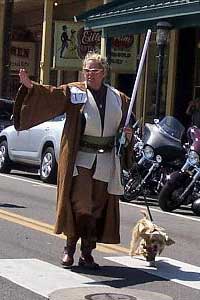 Plan ahead. If there is a particular event you will attend, then you know the dates available, or if you have kids to consider, you will tailor your visit to their interests. But if you want to absorb the essence of Virginia City for yourself, pick a date off-season, anything from early autumn to deep winter (the best) out to early Spring again.
Plan ahead. If there is a particular event you will attend, then you know the dates available, or if you have kids to consider, you will tailor your visit to their interests. But if you want to absorb the essence of Virginia City for yourself, pick a date off-season, anything from early autumn to deep winter (the best) out to early Spring again.
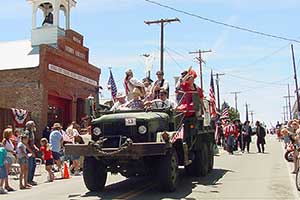 There is one important exception: Parades. Perhaps because it is so photogenic and lends itself enticingly as a backdrop for photos of the passing procession, Virginia City is now the City of Parades.
There is one important exception: Parades. Perhaps because it is so photogenic and lends itself enticingly as a backdrop for photos of the passing procession, Virginia City is now the City of Parades.
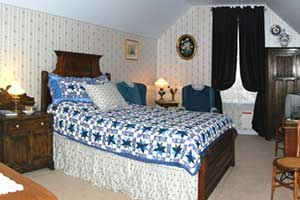
I believe there are nearly a dozen over the course of a year, and they add a festive quality to the day no matter what the occasion. They also add to the crowds and to the difficulty parking. Here is a list of Virginia City’s annual events.
Decide the date and book your room. And book your tickets for the V&T while you’re at it. You can choose from historic hotels and a nice modern one, B&Bs, motels, even an RV park. Here’s the list:
Arrive on a mid- to late Friday afternoon (this is the ideal; come when you can) and check in. The point is to get to town in time for a liesurely beginning to the evening ahead. Park your car and leave it; from now on you’re walking. Time for a nap? Take it.
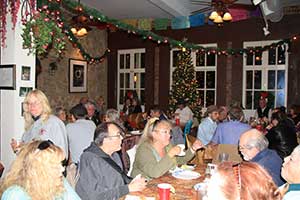
Mythologized as it is by everyone who has tried to write about it, Virginia City invites you for a pre-prandial stroll through the city with some window shopping and perhaps a refreshment on the way to dinner which will be at the acclaimed Cafe Del Rio, one of our three Nevada Restaurants of the Year for 2014, or at The Core, the ambitious new restaurant in a historic building on south B Street. The new Mustang Ranch Steak House at C and Union Streets advertises Storey County’s best-known commercial enterprise, which is the whorehouse at the other end of the county, east of Reno a few miles via I-80.
Nevada Restaurants of the Year for 2014, or at The Core, the ambitious new restaurant in a historic building on south B Street. The new Mustang Ranch Steak House at C and Union Streets advertises Storey County’s best-known commercial enterprise, which is the whorehouse at the other end of the county, east of Reno a few miles via I-80.
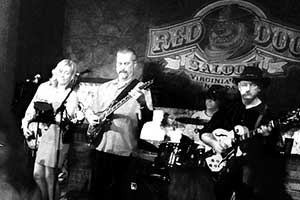 Strolling back to the hotel might involve a nightcap, and like the refreshment before dinner you will find any number of saloons available to provide it. Some of them are famous — the Delta, the Bucket of Blood, the Red Dog Saloon — others not. Several of them offer entertainment on weekends, open mic on other nights. Go for it.
Strolling back to the hotel might involve a nightcap, and like the refreshment before dinner you will find any number of saloons available to provide it. Some of them are famous — the Delta, the Bucket of Blood, the Red Dog Saloon — others not. Several of them offer entertainment on weekends, open mic on other nights. Go for it.
Up early? Roll over and drift back to dreamland; Virginia City especially likes to sleep in on Sundays. Eventually you will be hungry though, and you’ll find breakfast on C Street. We had biscuits and Gravy at a sidewalk table outside Virginia City Baked Goods, but here are some other choices, including a brunch at the Cafe Del Rio. 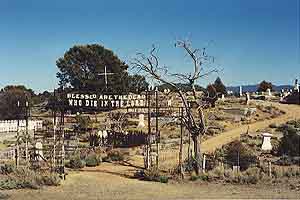
Make a stroll in the cemeteries your first order of business after breakfast and before the heat of the day, as there’s not much shade. I can’t imagine anyone wandering here without conjuring images of at least some of these people, and their lives here, as if phrases carved in stone could be clues to lives lived flesh-and-blood.
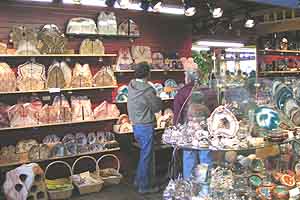 The shops are generally open by 10, and the saloons too, most of which have historical artifacts or photographs on display, if you need a reason to go in. By the time you’ve strolled the length of C Street you’ll have decided on your lunch stop. Here’s the list.
The shops are generally open by 10, and the saloons too, most of which have historical artifacts or photographs on display, if you need a reason to go in. By the time you’ve strolled the length of C Street you’ll have decided on your lunch stop. Here’s the list.
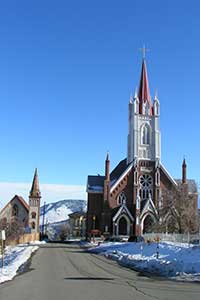 The afternoon may call for a siesta, but if you consult your list of local attractions over lunch you can draw up the itinerary for the rest of your stay. Hmmm, shopping. There was a time in the long-ago past when shopping in Virginia City was rubber tomahawks and sno-cones. No longer. There are exceptional shops here now. Use the comment section at the bottom to point to the best of them.
The afternoon may call for a siesta, but if you consult your list of local attractions over lunch you can draw up the itinerary for the rest of your stay. Hmmm, shopping. There was a time in the long-ago past when shopping in Virginia City was rubber tomahawks and sno-cones. No longer. There are exceptional shops here now. Use the comment section at the bottom to point to the best of them.
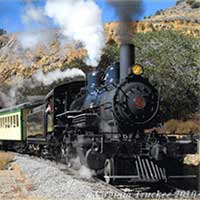 Check off the cemeteries and you still have some icons of western Americana to inspect: Piper’s Opera House, St. Mary in the Mountains Catholic church, St. Mary’s Art & Retreat Center (originally a hospital), the Fourth Ward School and the V&T Railroad — you’ll have to prioritize them for yourself, but don’t stint. These are relics from a different time and they are magnificent.
Check off the cemeteries and you still have some icons of western Americana to inspect: Piper’s Opera House, St. Mary in the Mountains Catholic church, St. Mary’s Art & Retreat Center (originally a hospital), the Fourth Ward School and the V&T Railroad — you’ll have to prioritize them for yourself, but don’t stint. These are relics from a different time and they are magnificent.
You’ll have your dinner planned by now, and have given some thought as to spending your Saturday night on the town. For a place with such a parade of questionable characters in its pantheon of pioneers (some of them quite violent), Virginia City’s nightlife seems mild and well-mannered now. Here’s the official list of saloons.
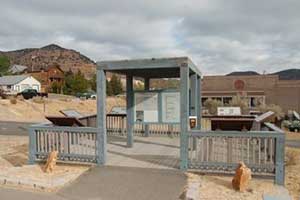 Your Sunday morning walk after breakfast will be along the Comstock Trail, a four mile walk — all right, hike. It is also a self-guided tour, with a brochure provided for you to take along. The No Driving rule is suspended so you can drive to the Kiosk at the bottom of Washington Street and back.
Your Sunday morning walk after breakfast will be along the Comstock Trail, a four mile walk — all right, hike. It is also a self-guided tour, with a brochure provided for you to take along. The No Driving rule is suspended so you can drive to the Kiosk at the bottom of Washington Street and back.
Drama has been a Virginia City specialty from before its beginning; the stories of the Grosh Brothers, Old Pancake, Joe Plato and Manny Penrod and other residents of Gold Canyon were being told before James Fenimore dropped his bottle of whiskey and rescued the moment by christening Virginia City with it.
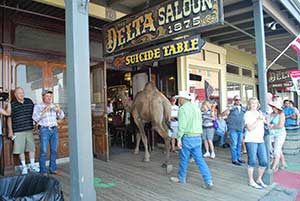 The Camel Races began as a newspaper hoax, emerged as a hilarious escapade, and is now an important annual event. Street Vibrations is motorcycle heaven and the Fourth of July fireworks display is truly spectacular. There’s a great Veterans’ Day parade, and Memorial Day and Labor Day too, A miner’s muckfest has been added to the calendar this year — but unless you have kids or special interests, you should probably avoid coming when there’s a special event scheduled. There are too many people in town for comfort, and parking is farther and farther away from the center of town.
The Camel Races began as a newspaper hoax, emerged as a hilarious escapade, and is now an important annual event. Street Vibrations is motorcycle heaven and the Fourth of July fireworks display is truly spectacular. There’s a great Veterans’ Day parade, and Memorial Day and Labor Day too, A miner’s muckfest has been added to the calendar this year — but unless you have kids or special interests, you should probably avoid coming when there’s a special event scheduled. There are too many people in town for comfort, and parking is farther and farther away from the center of town.
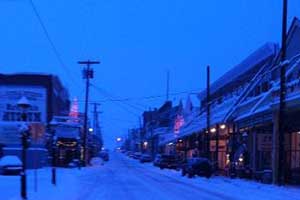 Come off-season (September – May) or at least on off-days — the more of Virginia City you have to yourself, the more you are likely to enjoy it to the hilt.
Come off-season (September – May) or at least on off-days — the more of Virginia City you have to yourself, the more you are likely to enjoy it to the hilt.
Whenever you come, bring your curiosity and do your best to satisfy it while you’re here. By the time you drive away for home you’ll have stored a set of memories that will stay with you . . . forever?



